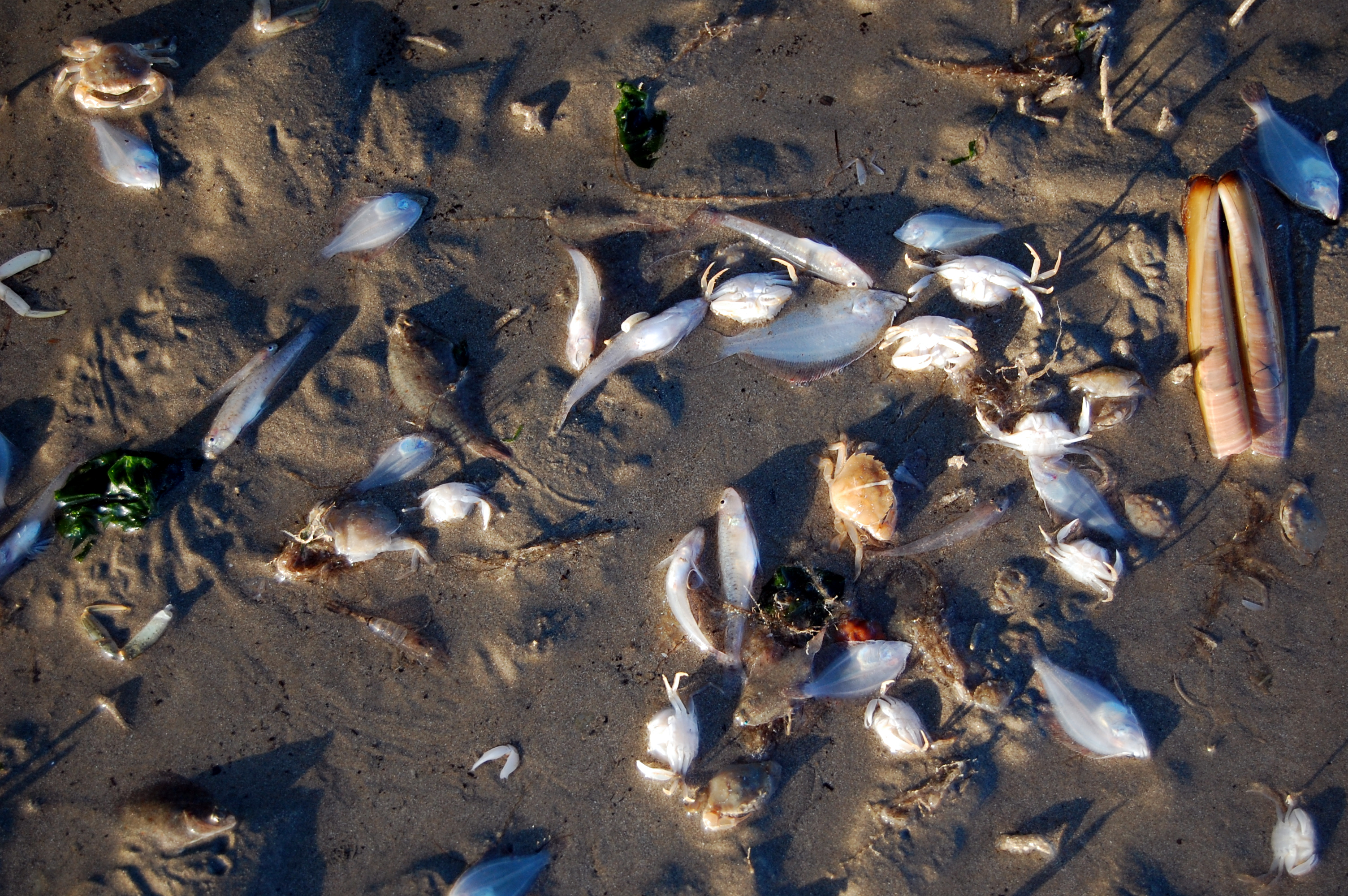|
Somniosus Antarcticus
The southern sleeper shark or Whitley's sleeper shark (''Somniosus antarcticus'') is a deepwater benthopelagic sleeper shark of the family Somniosidae found in the southern Atlantic, Indian, and Pacific Oceans. Taxonomy It was formerly sometimes viewed as conspecific with either the Greenland shark (''Somniosus microcephalus''), or the Pacific sleeper shark (''Somniosus pacificus''). Habitat It is known from depths of 400 to 1,100 m. Description Its length is up to . The southern sleeper shark differs from ''S. microcephalus'' in having more tooth rows in the lower jaw, a shorter interdorsal region, a more posterior first dorsal fin, and fewer precaudal vertebrae, and from both species in having lower dorsal fins. Diet It feeds primarily on cephalopods, especially squid- including the Giant and colossal squids- and fish; its stomach contents also less commonly contain remains of marine mammals and birds. Based on its generally sluggish nature and the speed of its prey, it i ... [...More Info...] [...Related Items...] OR: [Wikipedia] [Google] [Baidu] |
Gilbert Percy Whitley
Gilbert Percy Whitley (9 June 1903 – 18 July 1975) was a British-born Australian ichthyologist and malacologist who was Curator of Fishes at the Australian Museum in Sydney for about 40 years. He was born at Swaythling, Southampton, England, and was educated at King Edward VI School, Southampton and the Royal Naval College, Osborne. Whitley migrated with his family to Sydney in 1921 and he joined the staff of the Australian Museum in 1922 while studying zoology at Sydney Technical College and the University of Sydney. In 1925 he was formally appointed Ichthyologist (later Curator of Fishes) at the Museum, a position he held until retirement in 1964. During his term of office he doubled the size of the ichthyological collection to 37,000 specimens through many collecting expeditions. Whitley was also a major force in the Royal Zoological Society of New South Wales, of which he was made a Fellow in 1934 and where he served as president during 1940–41, 1959–60 and 1973� ... [...More Info...] [...Related Items...] OR: [Wikipedia] [Google] [Baidu] |
Chile
Chile, officially the Republic of Chile, is a country in the western part of South America. It is the southernmost country in the world, and the closest to Antarctica, occupying a long and narrow strip of land between the Andes to the east and the Pacific Ocean to the west. Chile covers an area of , with a population of 17.5 million as of 2017. It shares land borders with Peru to the north, Bolivia to the north-east, Argentina to the east, and the Drake Passage in the far south. Chile also controls the Pacific islands of Juan Fernández, Isla Salas y Gómez, Desventuradas, and Easter Island in Oceania. It also claims about of Antarctica under the Chilean Antarctic Territory. The country's capital and largest city is Santiago, and its national language is Spanish. Spain conquered and colonized the region in the mid-16th century, replacing Inca rule, but failing to conquer the independent Mapuche who inhabited what is now south-central Chile. In 1818, after ... [...More Info...] [...Related Items...] OR: [Wikipedia] [Google] [Baidu] |
Fish Of The Indian Ocean
Fish are aquatic, craniate, gill-bearing animals that lack limbs with digits. Included in this definition are the living hagfish, lampreys, and cartilaginous and bony fish as well as various extinct related groups. Approximately 95% of living fish species are ray-finned fish, belonging to the class Actinopterygii, with around 99% of those being teleosts. The earliest organisms that can be classified as fish were soft-bodied chordates that first appeared during the Cambrian period. Although they lacked a true spine, they possessed notochords which allowed them to be more agile than their invertebrate counterparts. Fish would continue to evolve through the Paleozoic era, diversifying into a wide variety of forms. Many fish of the Paleozoic developed external armor that protected them from predators. The first fish with jaws appeared in the Silurian period, after which many (such as sharks) became formidable marine predators rather than just the prey of arthropods. Most ... [...More Info...] [...Related Items...] OR: [Wikipedia] [Google] [Baidu] |
Fish Of The Atlantic Ocean
Fish are aquatic, craniate, gill-bearing animals that lack limbs with digits. Included in this definition are the living hagfish, lampreys, and cartilaginous and bony fish as well as various extinct related groups. Approximately 95% of living fish species are ray-finned fish, belonging to the class Actinopterygii, with around 99% of those being teleosts. The earliest organisms that can be classified as fish were soft-bodied chordates that first appeared during the Cambrian period. Although they lacked a true spine, they possessed notochords which allowed them to be more agile than their invertebrate counterparts. Fish would continue to evolve through the Paleozoic era, diversifying into a wide variety of forms. Many fish of the Paleozoic developed external armor that protected them from predators. The first fish with jaws appeared in the Silurian period, after which many (such as sharks) became formidable marine predators rather than just the prey of arthropods. Most fi ... [...More Info...] [...Related Items...] OR: [Wikipedia] [Google] [Baidu] |
Somniosus
''Somniosus'' is a widely distributed genus of deepwater dogfish sharks in the family Somniosidae. Several members of the genus are believed to attain lengths up to , thus ranking among the largest of sharks. Species * '' Somniosus antarcticus'' Whitley, 1939 (southern sleeper shark) * †'' Somniosus gonzalezi'' Welton & Goedert, 2016 – fossil, Oligocene * '' Somniosus longus'' Tanaka, 1912 (frog shark) * ''Somniosus microcephalus'' ( Bloch & J. G. Schneider, 1801) (Greenland shark) * '' Somniosus pacificus'' Bigelow & Schroeder, 1944 (Pacific sleeper shark) * '' Somniosus rostratus'' A. Risso, 1827 (little sleeper shark) * ''Somniosus'' sp. A Not yet described (longnose sleeper shark) Image:Somniosus microcephalus okeanos.jpg , ''Somniosus microcephalus'' Image:Somniosus pacificus noaa2.jpg, '' Somniosus pacificus'' Image:Somniosus rostratus adult JGF.jpg, '' Somniosus rostratus'' Image:Somniosus antarcticus.jpg, '' Somniosus antarcticus'' See also * List of prehist ... [...More Info...] [...Related Items...] OR: [Wikipedia] [Google] [Baidu] |
New Zealand Threat Classification System
The New Zealand Threat Classification System is used by the Department of Conservation to assess conservation priorities of species in New Zealand. The system was developed because the IUCN Red List, a similar conservation status system, had some shortcomings for the unique requirements of conservation ranking in New Zealand. plants, animals, and fungi are evaluated, though the lattermost has yet to be published. Algae were assessed in 2005 but not reassessed since. Other protists have not been evaluated. Categories Species that are ranked are assigned categories: ;Threatened This category has three major divisions: ::*Nationally Critical - equivalent to the IUCN category of Critically endangered ::*Nationally Endangered - equivalent to the IUCN category of Endangered ::*Nationally Vulnerable - equivalent to the IUCN category of Vulnerable ;At Risk This has four categories: ::*Declining ::*Recovering ::*Relict ::*Naturally Uncommon ;Other categories ;;Introduced and Natu ... [...More Info...] [...Related Items...] OR: [Wikipedia] [Google] [Baidu] |
Department Of Conservation (New Zealand)
The Department of Conservation (DOC; Māori: ''Te Papa Atawhai'') is the public service department of New Zealand charged with the conservation of New Zealand's natural and historical heritage. An advisory body, the New Zealand Conservation Authority (NZCA) is provided to advise DOC and its ministers. In addition there are 15 conservation boards for different areas around the country that provide for interaction between DOC and the public. Function Overview The department was formed on 1 April 1987, as one of several reforms of the public service, when the '' Conservation Act 1987'' was passed to integrate some functions of the Department of Lands and Survey, the Forest Service and the Wildlife Service. This act also set out the majority of the department's responsibilities and roles. As a consequence of Conservation Act all Crown land in New Zealand designated for conservation and protection became managed by the Department of Conservation. This is about 30% of New ... [...More Info...] [...Related Items...] OR: [Wikipedia] [Google] [Baidu] |
Patagonian Toothfish
The Patagonian toothfish (''Dissostichus eleginoides'') is a species of notothen found in cold waters () between depths of in the southern Atlantic, Pacific, and Indian Oceans and Southern Ocean on seamounts and continental shelves around most Subantarctic islands. A close relative, the Antarctic toothfish (), is found farther south around the edges of the Antarctic shelf, and a Marine Stewardship Council-certified fishery is active in the Ross Sea. Both species are sometimes marketed as Chilean sea bass. The average weight of a commercially caught Patagonian toothfish is , depending on the fishery, with large adults occasionally exceeding . They are thought to live up to 50 years and to reach a length up to . Several commercial fisheries exist for Patagonian toothfish, which are detailed below. Taxonomy The Patagonian toothfish was first formally described in 1898 by the Swedish zoologist Fredrik Adam Smitt with the type locality given as Puerto Toro at 55°24'S, 68°17' ... [...More Info...] [...Related Items...] OR: [Wikipedia] [Google] [Baidu] |
Orange Roughy
The orange roughy (''Hoplostethus atlanticus''), also known as the red roughy, slimehead and deep sea perch, is a relatively large deep-sea fish belonging to the slimehead family (Trachichthyidae). The UK Marine Conservation Society has categorized orange roughy as "vulnerable to exploitation". It is found in , deep (bathypelagic, ) waters of the Western Pacific Ocean, eastern Atlantic Ocean (from Iceland to Morocco; and from Walvis Bay, Namibia, to off Durban, South Africa), Indo-Pacific (off New Zealand and Australia), and in the eastern Pacific off Chile. The orange roughy is notable for its extraordinary lifespan, attaining over 200 years. It is important to commercial deep-trawl fisheries. The fish is a bright, brick-red color, fading to a yellowish-orange after death. Like other slimeheads, orange roughy is slow-growing and late to mature, resulting in a very low resilience, making them extremely susceptible to overfishing. Many stocks (especially those off New Zealand an ... [...More Info...] [...Related Items...] OR: [Wikipedia] [Google] [Baidu] |
Bycatch
Bycatch (or by-catch), in the fishing industry, is a fish or other marine species that is caught unintentionally while fishing for specific species or sizes of wildlife. Bycatch is either the wrong species, the wrong sex, or is undersized or juveniles of the target species. The term "bycatch" is also sometimes used for untargeted catch in other forms of animal harvesting or collecting. Non- marine species ( freshwater fish not saltwater fish) that are caught (either intentionally or unintentionally) but regarded as generally "undesirable" are referred to as " rough fish" (mainly US) and "coarse fish" (mainly UK). In 1997, the Organisation for Economic Co-operation and Development (OECD) defined bycatch as "total fishing mortality, excluding that accounted directly by the retained catch of target species". Bycatch contributes to fishery decline and is a mechanism of overfishing for unintentional catch. The average annual bycatch rate of pinnipeds and cetaceans in the US from 199 ... [...More Info...] [...Related Items...] OR: [Wikipedia] [Google] [Baidu] |
Squaliformes
The Squaliformes are an order of sharks that includes about 126 species in seven families. Members of the order have two dorsal fins, which usually possess spines, they usually have a sharp head, no anal fin or nictitating membrane, and five to seven gill slits. In most other respects, however, they are quite variable in form and size. Most species of the squaliform order live in saltwater or brackish water. They are found worldwide, from northern to tropical waters, and from shallow coastal seas to the open ocean. All members of the family Eptomeridae and Dalatiidae and ''Zameus squamulosus'' possess photophores, luminous organs, and exhibit intrinsic bioluminescence. Bioluminescence evolved once in Squaliformes, approximately 111–153 million years ago, and helped the Squaliformes radiate and adapt to the deep sea. The common ancestor of Dalatiidae, Etmopteridae, Somniosidae, and Oxynotidae possessed a luminous organ and used bioluminescence for camouflage by counteri ... [...More Info...] [...Related Items...] OR: [Wikipedia] [Google] [Baidu] |




.gif)

